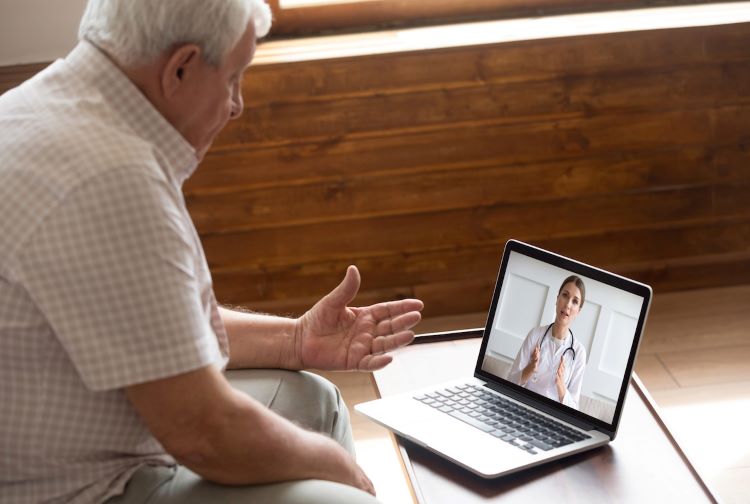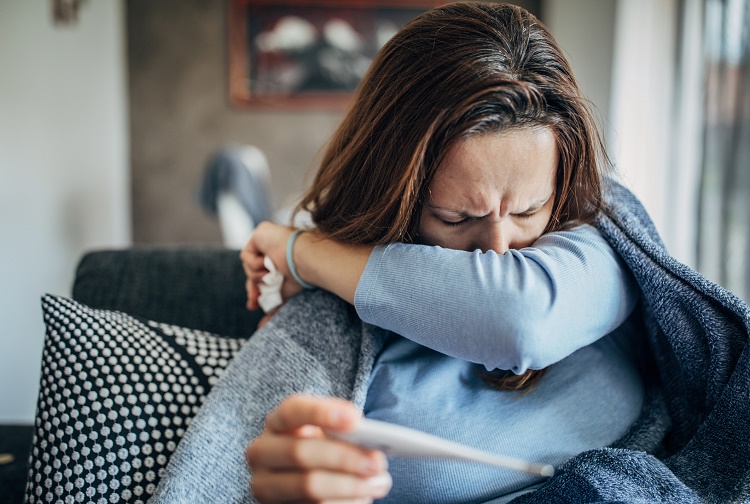
Telehealth takes on new meaning during COVID-19 pandemic
April 01, 2020
At VCU Health, doctors see a long-term project — bringing health care into our homes — gaining traction.
As social distancing becomes the norm of daily life around the world, people are discovering new and unique ways to do what they need to do remotely. And at VCU Health, some doctors are seeing one long-term project — to bring health care into our homes — gain much-needed traction.
“The future of health care is going to be technologically driven,” said Vimal Mishra, M.D., an associate professor in the Department of Internal Medicine at VCU’s School of Medicine. “And telehealth is about augmented care and how do we take care of the patient more efficiently and effectively with the resources we have.”
What is telehealth?
Telehealth is a broad spectrum of services, but it loosely refers to health care where the patient and the doctor are in separate locations — everything from a simple phone call to specialized machines on either end. And as doctors limit face-to-face appointments to align with social distancing guidelines and slow the spread of the novel coronavirus COVID-19, telehealth tools are going mainstream.
Mishra calls it “forward triage,” when someone with a fever or a dry cough calls the doctor. But this is also flu and allergy season: Not everyone has COVID-19, and many people recover from COVID-19 without needing special treatment.
Through telehealth, a doctor can ask basic questions like “do you have a fever?” and “have you traveled to a COVID hot spot recently?” The doctor can easily obtain a medical history and visually assess the patient. If the patient seems relatively fine, the doctor can prescribe medications, offer reassurance and set up a threshold to seek further care. Or the doctor can refer the patient to a testing site.
It’s not simply about interacting with potential COVID patients from afar if symptoms are mild, said Mishra, but about allowing non-COVID patients who need treatment to see a doctor or follow up without putting themselves at risk by traveling.
“Coronaviruses are being spread mostly by asymptomatic patients,” said Mishra, a hospitalist at VCU Health. “So if we are able to evaluate and treat you virtually, we minimize exposure to others and flatten the curve.”
At VCU Health, the number of telehealth visits is increasing every day. On March 31, VCU Health surpassed in-person visits with telehealth visits (videoconferencing and phone calls) for the first time, with 1,200 visits.
Mishra hopes the pandemic is a turning point for the mainstream use of telehealth. Where the telehealth focus previously has been on providing care in isolated areas, Mishra sees a tremendous gap in coverage for urban communities that struggle with mobility and access to medical care.
“This crisis is going to help us adapt the new technology,” Mishra said. “And it will create a conversation nationally, which will help us to create a paradigm of care.”
Providing care through distance
For treating chronic liver diseases, telehealth broadly encompasses three levels of care: virtual visits, telemedicine and peer-to-peer networks, said Richard Sterling, M.D., a liver specialist and chief of hepatology at VCU Health.
“Telehealth is basically providing some level of care through distance without the traditional touching of the patient,” Sterling said. “And that can be in a variety of settings.”
Virtual doctors’ visits are similar to Skype or FaceTime, Sterling said. But “telemedicine,” as opposed to telehealth, requires more infrastructure and on-site expertise. A computer with specialized equipment on the patient end can allow for more of a physical exam, in addition to the audio and video component.
“So there’s a stethoscope that’s hooked up to the equipment, and the nurse on the other end puts the stethoscope to the patient,” he said. “We can actually hear the breath sounds on the other end.” A nurse can also perform a limited exam under the direct supervision of the provider.
Sterling, a hepatology professor at VCU’s School of Medicine, has expanded the use of telemedicine to combat hepatitis C in patients at Virginia’s correctional facilities. The percentage of incarcerated people with chronic hepatitis C virus is higher than average, as the disease often results from illicit substances and opioid abuse. But transporting people in prison is costly and complex.
VCU Health's telemedicine growing
Since 2015, Sterling’s work with his team has treated more than 800 patients at Virginia correctional facilities from telemedicine rooms in VCU’s Nelson Clinic. HIV specialists, cardiologists and many other doctors at VCU Health also use the telemedicine technology and facilities.
Using the resources of VCU’s C. Kenneth and Dianne Wright Center for Clinical and Translational Research, including the use of dedicated clinical space for research in VCU Health’s North Hospital and data informatics, helped Sterling collaborate with other institutions.
Last year, Sterling published his initial findings about using telemedicine to treat hepatitis C in the Department of Corrections in the Journal of Correctional Health Care.
“Hepatitis C is one of the ideal diseases to treat through telemedicine because most people don't have any symptoms,” he said. “Everything can be done through blood tests and talking to the patient.”
Sterling said he hopes to see the program expanded for use in remote rural areas of Virginia where traveling long distances for specialists is difficult.
“I can envision freestanding telemedicine places, like when you go to your ATM,” said Sterling. “You’re told to be at the machine at 10 a.m., and someone on the other end is waiting for you. You could put the stethoscope on yourself, log in and dial up your specialist on the other end.”
Cost is a barrier to that vision, he added — both the machines themselves and the pay structure for the doctors. And, of course, telehealth will never replace that one-on-one patient-doctor experience. “But there are a lot of diseases where it can fill a gap, even a routine physical,” Sterling said.
Physicians can consult remotely on cases -- including COVID-19 cases
Another VCU telehealth initiative, Project Echo, hopes to bring technology into peer-to-peer consults. A physician, perhaps in a rural area, calls up a specialist or a doctor with particular expertise for treatment of their hepatitis C patients. Charts and vitals are shared securely in a way that allows for a full and effective consult, beyond the confines of the original doctor’s network. This treatment model could save time and money and allow patients to be treated in their communities by local providers with supervision by specialists at VCU Health.
“The coronavirus is relevant to Project Echo, too,” Mishra said. “Just think about what is happening in each and every health system right now: Hospitals are not able to understand and absorb all the data that is coming to them [about COVID-19]. With Echo, you can be a centrally located specialist and have nodes of connection asking questions as a community. You learn from each other and help the patients at the same time. It’s a knowledge network.”
Mishra foresees a world where the word “telehealth” is obsolete. “It is health,” he said. “It's about how we are delivering care using technology — utilizing the latest and the greatest to really support our patients and community. I want to take care of my patients wherever they are.”
The potential for the expansion of telehealth has been a small glimmer of hope for Mishra in these past chaotic weeks of the pandemic.
“As a doctor, it's a tragedy. It’s a crisis,” he said. “But we get trained for these things, and I think we have such a fantastic team [at VCU Health]. They put their patients and the community first. It's an honor and privilege to help.”
To participate in telehealth
VCU Health offers information about how patients can participate in telehealth. Please visit our telehealth page for more information.



